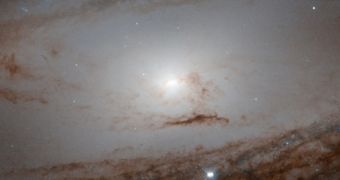A supernova blast that occurred in the spiral galaxy Messier 65 in March 2013 obscured the cosmic structure for several months, as the amount of light coming from this object overwhelmed light detectors such as those on the NASA/ESA Hubble Space Telescope.
At the end of the year, astronomers tried to image the galaxy again, and this time they were able to use Hubble's sensitive eyes to capture an amazing view of the object. The photo was released on December 30, 2013. Messier 65 lies in the Leo Constellation, some 40 million light-years away.
The object was first discovered by famous astronomer Charles Messier, in March 1780, who wrote “Nebula discovered in Leo: It is very faint and contains no star.” With the telescopes he had access to, there is no wonder that the skywatcher was unable to resolve any details except a faint blob of light.
M65 is part of the famous Leo Triplet group of small galaxies, alongside M66 and NGC 3628. The object contains very little gas, which means that stellar formation is not going on inside at very significant levels. In all likelihood, the galaxy is producing fewer stars per year than the Milky Way.

 14 DAY TRIAL //
14 DAY TRIAL //